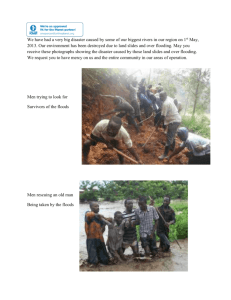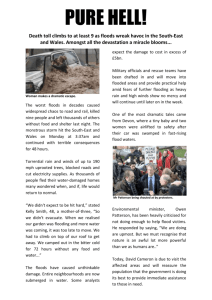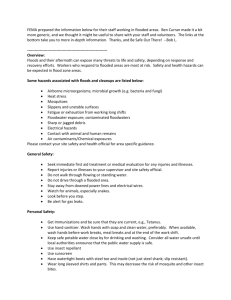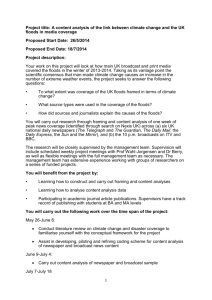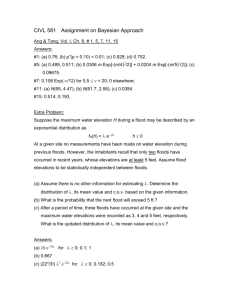geol_15_lecture_30_2..
advertisement
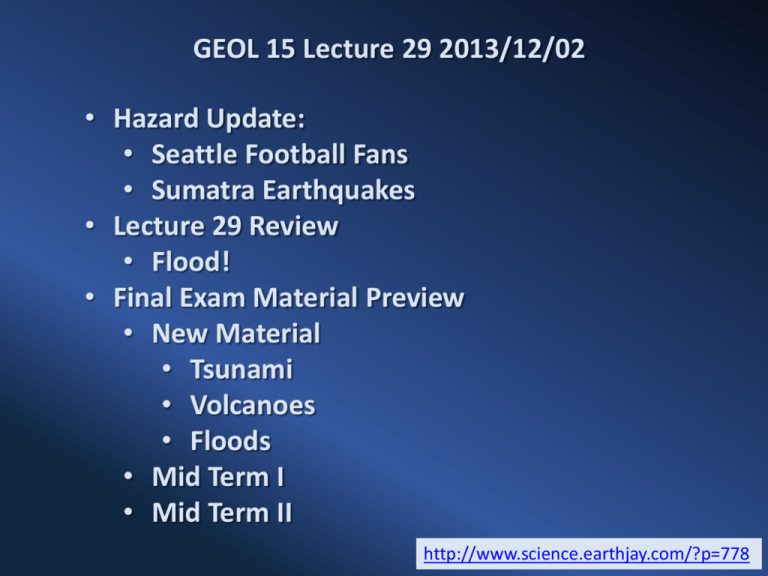
GEOL 15 Lecture 29 2013/12/02 • Hazard Update: • Seattle Football Fans • Sumatra Earthquakes • Lecture 29 Review • Flood! • Final Exam Material Preview • New Material • Tsunami • Volcanoes • Floods • Mid Term I • Mid Term II http://www.science.earthjay.com/?p=778 https://www.facebook.com/lori.dengler/posts/10200904338882916?comment_id= 56815465&ref=notif&notif_t=like https://www.facebook.com/photo.php?fbid=482235371475&set=a.74925066475.78273.6276351475&comments http://www.livescience.com/41654-seahawks-fans-trigger-earthquake.html Seismogram showing the frequency (hz) vs. the time in seconds, which is plotted along the horizontal axis. The Seahawks came to the line on the play that resulted in Marshawn Lynch's touchdown run at somewhere between 98 and 100 seconds on the graphic. From: John Vidale, director of the PNSN http://seattletimes.com/html/seahawksblog/2013897125_seismictimelineofmarshawnlynchstouchdownrun.html 101 - 103: Ball hiked. 105 - 107: Marshawn Lynch hits the hole. 107 - 109: Lynch breaks through the line. 110 - 112: Lynch breaks another tackle. 112 - 114: Lynch shoves Saints cornerback Tracy Porter, knocking him 5 yards downfield. 117 - 119: Lynch crosses the goal line, corresponding to the biggest burst of energy. 159 - 161: Extra-point is kicked by Olindo Mare. 179 - 181 Possibly the replay was shown in the stadium. 168 - 170: Replay possibly shown in slow motion. 213 - 215: Seattle kicks off to the Saints, play resumes. FLOOD! What is a flood? A flood is an event where water inundates land that is normally dry. Floods are a natural process that can be caused by a number of factors and affected by human activities. Floods occur at irregular intervals and no two floods are the same. Floods can occur suddenly Sudden, heavy and intense rainfall can cause floods to quickly rise in the minutes or hours that follow. These are known as flash floods and are typically associated with relatively small catchment areas. Floods can occur slowly In large catchment areas, rainfall can build up over hours, days or weeks. The runoff from this rainfall may create significant floods that inundate large areas of land for days, weeks or months. Most of the largest known floods of the Quaternary Period resulted from breaching of dams formed by glaciers or landslides. • Types: • Ice-Dam or Landslide-Dam Failure • Lake Overflow (many kinds) • Volcanic Eruption • Ice Jam or Snowmelt • Meteorological/Rainfall (most common) The late-Pleistocene Missoula floods in the Pacific Northwestern United States were some of the largest ever to have occurred on Earth. The floods resulted from the repeated breaching of an ice dam formed from a lobe of the Cordilleran Ice Sheet that blocked the present-day Clark Fork River and created an immense lake known as glacial Lake Missoula. http://hugefloods.com/LakeMissoula.html An illustration of factors that contribute to floods. http://www.chiefscientist.qld.gov.au/publications/understanding-floods.aspx Basin/Catchment - The surface area of land that collects and drains water into a river or other waterway. http://ut.water.usgs.gov/publications/fs245-96/ A manual stream gauging station on the Fitzroy River, Rockhampton, January 2011. Note the historical reference to heights of previous floods: 1918, 1954, and 1991. http://waterwatch.usgs.gov/?m=mkrc&sno=11475000 “flashy” Luckiamute River, Jan. 19, 2012 TSUNAMI! Atwater et al., 2005 Atwater et al., 2005 Patton, 2013 CGS, 2009 Geology 15 Activity 10 B Tsunami and Tide Gage Records 2001 Peru Tavera et al., 2006 Tavera et al., 2006 Tsunami deposit at La Quinta overlying agricultural soil. A thin layer of mud divides the deposit into two distinct layers. Jaffe et al., 2003 VOLCANO! Lava mapped in 17th and 18th centuries http://www.old-map-blog.com/wp-content/uploads/2010/01/Vesuv_Mount_Vesuvius.jpg Excavated in 20th century Herculaneum AD 79. A large number of people were sheltering in this seaside boathouse. The ancient Roman town was destroyed by the same Mt. Vesuvius eruption that took out Pompeii. https://www.pinterest.com/pin/470978073501952619/ • Hot Spots • Rifts • Subduction Zones CASCADES VOLCANO! http://volcanoes.usgs.gov/images/pglossary/VolRocks.php http://volcanoes.usgs.gov/images/pglossary/basalt.php Basalt is a hard, black volcanic rock with less than about 52 weight percent silica (SiO2). Because of basalt's low silica content, it has a low viscosity (resistance to flow). Therefore, basaltic lava can flow quickly and easily move >20 km from a vent. The low viscosity typically allows volcanic gases to escape without generating enormous eruption columns. Basaltic lava fountains and fissure eruptions, however, still form explosive fountains hundreds of meters tall. http://volcanoes.usgs.gov/images/pglossary/andesite.php Andesite is a gray to black volcanic rock with between about 52 and 63 weight percent silica (SiO2). Andesite magma commonly erupts from stratovolcanoes as thick lava flows, some reaching several km in length. Andesite magma can also generate strong explosive eruptions to form pyroclastic flows and surges and enormous eruption columns. Andesites erupt at temperatures between 900 and 1100° C. http://volcanoes.usgs.gov/images/pglossary/dacite.php Dacite lava is most often light gray, but can be dark gray to black. Dacite lava consists of about 63 to 68 percent silica (SiO2). It is one of the most common rock types associated with enormous Plinian-style eruptions. When relatively gas-poor dacite erupts onto a volcano's surface, it typically forms thick rounded lava flow in the shape of a dome. http://volcanoes.usgs.gov/images/pglossary/rhyolite.php Rhyolite is a light-colored rock with silica (SiO2) content greater than about 68 weight percent. Sodium and potassium oxides both can reach about 5 weight percent. Common mineral types include quartz, feldspar and biotite and are often found in a glassy matrix. Rhyolite is erupted at temperatures of 700 to 850° C. Volcanic Hazard Mt. Lassen • Mid Term I • Scientific Method • Energy • Earthquakes • Stress and Strain • Elastic Rebound Theory • Earth’s Structure • Plate Tectonics • Plate Boundaries • Plate Movement • Faults • Intensity/Magnitude • Seismology • Mid Term II • Earthquake Magnitude • Earthquake Cycles • Focal Mechanisms • Paleoseismology • Geodesy • Final • TSUNAMI! • VOLCANO! • FLOOD!

